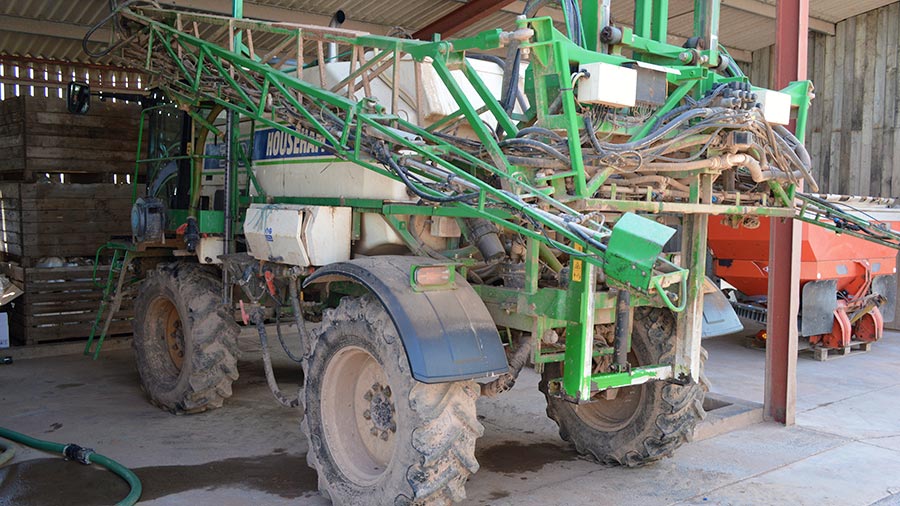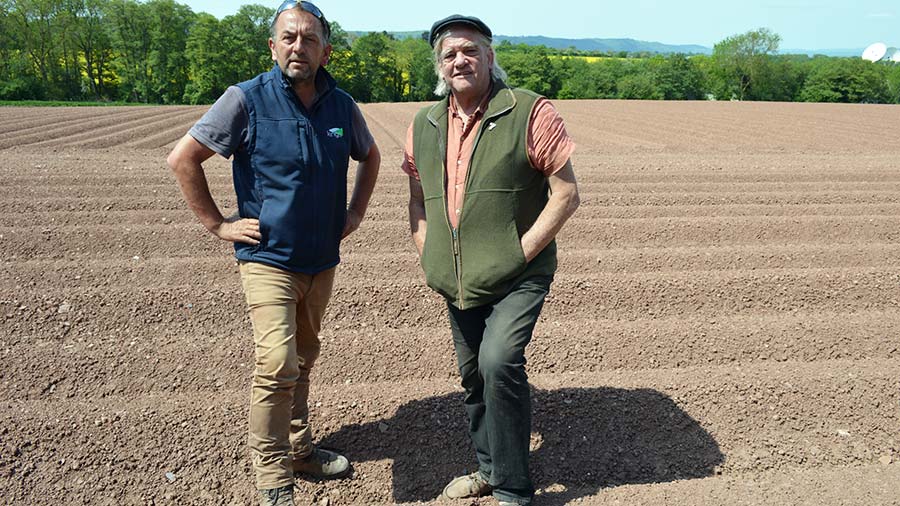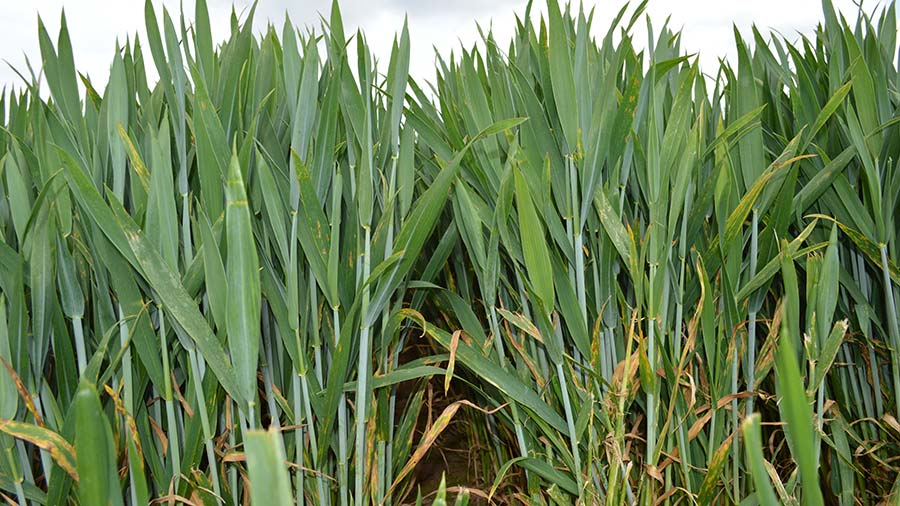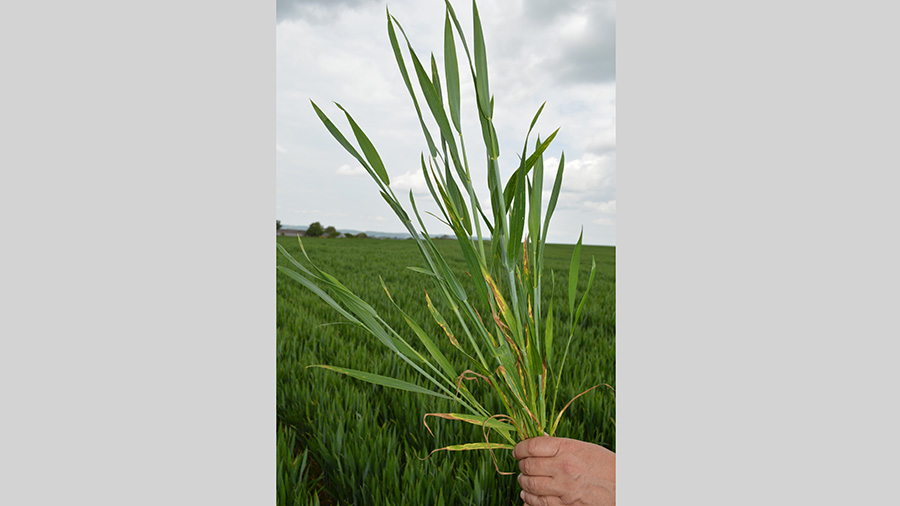What’s in Your Fertiliser Shed? Approach targets river health
 © MAG/David Jones
© MAG/David Jones John Watkins is using granular nitrogen for his base-line crop nutrition and topping up with a foliar treatment later in the season.
He farms with a clear focus on the environment in an area of Herefordshire under the spotlight for river pollution.
By using relatively low levels of solid nitrogen fertiliser early in the season, he can top up his winter wheat, barley and also potatoes with foliar nitrogen later.
This avoids any chance of over-fertilising his crops and allowing runoff into watercourses.
“Everything I do is to try and reduce any chance of nitrogen leaching into the river,” he tells Farmers Weekly from his arable and poultry farm, which has streams draining into the nearby River Wye.
See also: What’s in Your Fertiliser Shed? Grower favours solid nitrogen for milling wheats
Farm facts
John Watkins, Arkstone Court, Clehonger, Herefordshire

Frontier agronomist Lee Ward, left, and farmer John Watkins © MAG/David Jones
- Soils Medium loam sandstone to sands
- Farming 1,000ha of arable land
- Winter wheat 440ha
- Potatoes 180ha
- Oilseed rape 130ha
- Grassseed 80ha
- Vining peas for seed 70ha
- Winter barley 50ha
- Environmental schemes and other areas 50ha
- Sprayer Househam 24m with 3,500 litre capacity
- Spreader Kuhn Axis 24m
River pollution
Herefordshire farmers have come in for criticism over the high phosphate levels in the Wye, which could have come from spreading poultry manure and soil erosion from growing maize.
But John stores all his poultry manure securely under cover and does not grow maize.
He also has wide protective grass margins around all the watercourses on his farm to reduce the chance of any nitrates leaching from his free-draining soils and into the River Wye.
Farming 1,000ha of arable cropping at Arkstone Court, just south-west of Hereford, the emphasis is on efficient nitrogen fertiliser use for both financial and environmental reasons.
He uses a four-way split of solid and foliar nitrogen fertiliser for his feed winter wheats to achieve average yields of 11t/ha across his fertile loamy soils.
For his winter wheat and winter barley crops, John uses high-quality ammonium nitrate, as in CF Nitram (34.5%N), early in the season,.
This is when the farm’s Househam 24m, 3,500-litre sprayer is fully occupied with herbicide and fungicide spraying, and so a liquid nitrogen approach is not an option.
He grows 440ha of winter wheat including varieties such as Graham, Dawsum and Extase (grown for feed), and looks to provide them with a base level of a relatively modest 130kg/ha of solid nitrogen fertiliser by mid-April.
Three-way split
With his winter wheats, he looks to apply a three-way split of solid nitrogen in largely equal amounts, which allows him the option of topping up with a foliar nitrogen treatment later in the growing season.
“We are applying nitrogen four times on the winter wheats in small doses, which will give the best chance of good uptake by the plants,” he says.
His soil fertility is generally good and soil organic matter levels are in good shape at 3-4%, as he is spreading cattle manure before his one-in-six-year potato crops and poultry manure before oilseed rape.
He also chops most of his cereal straw.
The first nitrogen application is of CF Nitram in late February-early March.
He follows that with a protected urea plus sulphur product, Sustain 33N 30S, in mid-late March, and then CF Nitram again in mid-April, all applied with his Kuhn Axis 24m spreader.
The coated urea product is used to give an opportunity to get sulphur applied to the crop without a separate pass with the spreader, while the protected nature of the urea aims to avoid any volatilisation.

John Watkins’ winter wheat crop © MAG/David Jones
Switch to foliar
At the flag-leaf stage in mid-May, he then applies the foliar urea polymer Nutrino Pro to help push up grain yields.
He is applying 20 litres/ha to provide 6-7kg/ha of nitrogen, which performs similarly to 30-40kg/ha of solid ammonium nitrate.
The product is a low-scorch liquid nitrogen formulation which releases nitrogen over six to eight weeks.
It also contains magnesium and sulphur as well as the biostimulants R100 and pidolic acid, which help to improve nutrient uptake by the crop.
“We have seen no scorch from using the product and the nitrogen is readily available to the plant, while it can be tank-mixed with a T2 fungicide to save on an extra pass,” says John.
“With the spray sticking to the leaf, it is a very efficient way of applying nitrogen, and environmentally friendly.”
He and his agronomist, Lee Ward from advisory group Frontier, are both impressed with the foliar product which was used for the second season this spring.
The approach is being backed up by what the N-tester – which measures leaf nitrogen – is showing about the crop’s need for nutrition.
This hand-held leaf nitrogen measuring tool from fertiliser group Yara can monitor a crop’s nitrogen status and give an instant field recommendation of the nitrogen needs of a range of crops.
“The Nutrino Pro gives us more flexibility, more accuracy and better efficiency in getting nitrogen into the crop,” says Lee.

Septoria disease is restricted to the lower leaves of the winter wheat © MAG/David Jones
Potatoes and rapeseed
John is also using the foliar nitrogen product as a post-flowering treatment on his oilseed rape to boost seed yields.
It is also used as a post-flowering spray on his potato crops as an efficient way of getting nitrogen into the crop, especially with the potato variety Innovator grown for the frozen chipping market.
“We tend to be mean with seed-bed fertiliser for the potato crop, so we can always top up later, post-flowering, with the foliar spray to keep the crop green and so get more yield,” he says.
The foliar nitrogen product can be mixed with regular potato blight sprays, and is applied at 20 litres/ha, but this could easily be a split dose with both incorporated into a blight spraying programme.
This has resulted in good potato yields of 42-48t/ha on the farm.
John is satisfied with his granular and foliar fertiliser mix approach as it does not put undue pressure on sprayer capacity early in the season and, in his view, is the most efficient way of applying nitrogen.
“We see a climate change zone type of farming, applying nitrogen little and often and avoiding any leaching into the nearby river. We cannot be seen to be over-applying fertiliser,” he says.
In the next of our farm visits in this three-part series, we travel to northern Kent to talk to a grower who has moved completely to liquid fertilisers and has managed to avoid any scorch problems or sprayer bottlenecks.

